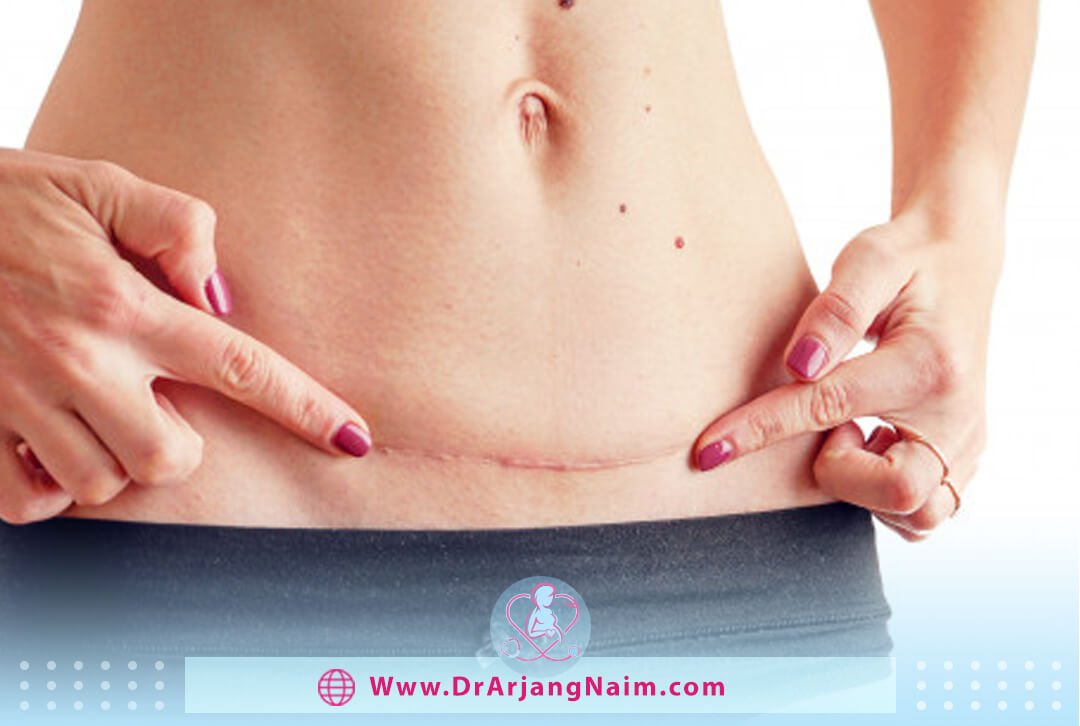Vaginal birth after a cesarean section is known as VBAC. Vaginal birth has advantages over cesarean delivery. When a mother has had a cesarean section, she may decide to have a normal delivery for the second time. Although many mothers have had successful natural childbirth after a cesarean section, determining whether a person is a viable option for a natural birth after a cesarean section requires consultation with an obstetrician.
Vaginal birth benefits
The main reasons for choosing VBAC are:
- Impact on future pregnancies: If a woman wants more children, VBAC may help prevent multiple risks of cesarean delivery, such as placenta previa or placenta accreta.
- Lower risk of surgical complications: Vaginal birth after cesarean sections is associated with a reduction in excessive bleeding, infection and blood clots in one or more arteries and may also reduce the risk of hysterectomy and damage to abdominal organs such as the bladder or bowel.
- The child receives beneficial bacteria: When a baby passes through the birth canal, it swallows the bacteria that help keep the gut healthy and boost its immune system. Some studies have shown that babies born by cesarean section do not receive these essential bacteria.
- Shorter recovery time: Shorter recovery time after vaginal delivery shortens hospital stay than a cesarean section. Avoiding surgery helps the mother resume normal activities sooner.
- Probability of breastfeeding sooner: According to WHO studies in current research, early breastfeeding (in the first hour after birth) increases the likelihood of breastfeeding exclusively from one to four months. As well as the overall duration of breastfeeding. Because of colostrum and breastfeeding benefits in general, the WHO recommends that breastfeeding be started as soon as possible after birth. Studies have shown that early breastfeeding after cesarean section is lower than vaginal delivery.
- Opportunity for an individualized birth plan: For some women, the experience of having a vaginal delivery is significant.
How does a woman know that having a VBAC is right for her?

If a woman is thinking about having a VBAC, she should talk to her doctor. The obstetrician can help assess the risks and benefits. If the risks are low and the chances of having a successful VBAC are high. The doctor may decide that vaginal birth after cesarean sections is appropriate. A woman has a better chance of having a successful vaginal birth after cesarean sections if:
- In the past, they only had one C-section with a low transverse incision
- The mother and baby were in good health during the pregnancy
- Labor starts on its own just before or on her due date
- They had a vaginal birth before
A woman is less likely to have a successful VBAC if:
- In this pregnancy, women have the same conditions that necessitate a cesarean section in a previous pregnancy. For example, a baby has a heart problem or is lying on his side in the womb.
- A woman past her due date
- An excess amount of body fat causes obesity before pregnancy or overweight during pregnancy, and a body mass index is 30 or higher.
- A pregnant mother has preeclampsia. This condition can occur after the 20th week of pregnancy or after pregnancy. This is when a pregnant woman has high blood pressure, which sign that some parts of her body, such as her kidneys and liver, may not be working correctly. Symptoms of preeclampsia include proteinuria, changes in vision, and severe headaches.
- Less than 18 months between the last pregnancy and the current pregnancy.
- The baby is huge
- Over 35 years or a race other than white
- If a woman has more than two cesarean sections or is pregnant with triplets or more, some providers may not offer VBAC.
Risks of natural childbirth after cesarean section
If a woman meets the requirements for a normal delivery after a cesarean section, there is very little risk, less than one percent, of the uterus rupturing at the site of the previous cesarean section, leading to heavy bleeding and possibly deprivation of oxygen to the baby. Delivery may also take hours. Leading to normal and emergency cesarean sections, which will have more complications than normal postpartum delivery and a pre-scheduled cesarean.
An emergency cesarean section is more likely to cause severe postpartum hemorrhage and even loss of the uterus or infection of the uterus. Finally, the baby may have a serious complication that can lead to long-term nerve damage or even death.
Although this is very unlikely overall, it may be higher in women who have had a failed vaginal delivery after a cesarean than in women who have had a successful vaginal delivery or a pre-planned cesarean. A change in the fetus’s heart rate is usually the first sign of a problem. If a woman decides to have a vaginal delivery despite having a history of cesarean section, she needs constant monitoring of the fetus by an obstetrician or midwife.
Disadvantages of vaginal birth after cesarean sections
In general, the disadvantages of vaginal birth after cesarean sections include the following:
- Emergency cesarean birth: There is a 25% chance that an emergency cesarean delivery is needed during labor, slightly higher than the mother’s chances of a first pregnancy.
- Blood transfusion and infection in the Uterus: Women who choose VBAC are 1% more likely to need a blood transfusion or have an infection in the womb than women who choose a planned cesarean delivery.
- Scar weakness or rupture: A scar can open in the uterus. If the scar is completely open (scar rupture), this can have serious consequences for both mother and baby. It occurs in only two to eight women out of 1000 (about 0.5%).
Preparing for vaginal birth after cesarean sections
If a woman has had a cesarean section and is now pregnant. She may start talking about VBAC at her first prenatal visit. A pregnant woman should share her concerns and expectations with an obstetrician. The doctor must have a complete history, such as a history of cesarean section or any other procedure performed on the uterus. The doctor uses medical history to calculate the likelihood of vaginal birth after successful cesarean sections.
Women should also plan to have their babies delivered by an emergency cesarean section. Continue to discuss the risks and benefits of VBAC during pregnancy, especially if there are certain risk factors.
Doctors usually recommend that women who choose VBAC deliver their baby at the hospital instead of giving birth or at home. This is because there is a need for careful monitoring to eliminate any complications quickly.
Arjang Naim MD and his team check the pregnant mother’s condition during regular visits. If there is a desire to have a vaginal delivery after a cesarean section, they check the possible conditions and risks and talk to the mother about all the details. And ultimately make the best decision.
How to increase the chances of a successful VBAC?
Many factors that contribute to successful VBAC are beyond the control of the mother, but some things can be done to increase the chances:
- During the first months of pregnancy, a pregnant mother should talk to her doctor about VBAC and ask if her doctor and hospital support VBAC.
- Weight management increases the chance vaginal birth after cesarean sections. Studies have shown that overweight women who have lost at least 1 unit of their body mass index increase their chances of a successful VBAC by 12% compared to women with Overweight women who maintain their weight. Women who decide to become pregnant should talk to their doctor about losing weight before pregnancy, managing their diet, and staying active during pregnancy.
Why is the type of uterine incision used in a previous cesarean delivery important?

After a cesarean delivery, the scar remains on the skin. Some uterine ulcers cause more rupture during VBAC than others. The type of wound depends on the type of uterine incision, which includes:
- Low transverse: An incision in the lower and thinner part of the uterus is made side by side. This is the most common type of incision and is least likely to rupture in the future.
- Low vertical: Up-and-down incisions are made in the thin and lower part of the uterus. This type of incision has a higher risk of rupture than a low transverse incision.
- High vertical: An incision is made in the upper and down part of the uterus. This is sometimes done for very premature cesarean deliveries. This type of incision has the highest risk of rupture.
The bottom line
If you have had a cesarean section delivery before and you want to have your next delivery in a natural way, you should definitely see a gynecologist and consult with him or her about this type of delivery.
You should fully explain your past cesarean section (vertical or horizontal incision) to your doctor. Then share any history of your illness with him or her so that he or she can check the condition and experience a normal delivery if confirmed.
Today, many doctors try to explain the benefits of natural childbirth to all mothers to discourage them from having a cesarean delivery. Some people think that when they have their first pregnancy by cesarean section, they will no longer be able to have a vaginal delivery, but this is a misconception. It is often possible to have a normal delivery. Finally, if you are in a good position to have a normal delivery, it is better to experience your next deliveries naturally so that you do not suffer from the complications of cesarean delivery.
Additional questions
- What is the main cause of placenta previa?
Some possible causes and risk factors for placenta previa include:
- Low implantation of the fertilized egg
- Abnormalities of the uterine lining, such as fibroids
- Scarring of the uterine lining (endometrium)
2. What is Placenta accreta?
Placenta accreta is a serious pregnancy condition that occurs when the placenta grows too deeply into the uterine wall. Normally, the placenta separates from the uterine wall after delivery. With placenta accreta, part or all of the placenta remains attached. This can cause severe blood loss after delivery.
3. What is a blighted ovum?
A missed egg, also called an embryonic pregnancy, occurs when an early embryo never develops or stops developing, is resorbed, and leaves an empty gestational sac.
4. How many layers are cut during C-section?
At the beginning of the caesarean section, six layers of the abdominal wall and the uterus are opened separately. After delivery, the uterus is closed with two layers of stitches.
5. What percentage of VBAC are successful?
The success rate of VBACs is between 60 and 80 percent. A VBAC usually has fewer risks than a repeat C-section and can have a shorter recovery time, hospital stay, and a better chance of successful breastfeeding.
References
https://www.marchofdimes.org/find-support/topics/birth/vaginal-birth-after-cesarean
https://www.mayoclinic.org/healthy-lifestyle/labor-and-delivery/in-depth/vbac/art-20044869
https://www.pregnancybirthbaby.org.au/vaginal-birth-after-caesarean-vbac
https://www.webmd.com/baby/vaginal-birth-after-c-section




